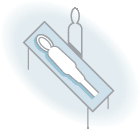- Case History
- Nursing Records
- Results
- Investigations
- Questions
- Answers
1. What do these gases show?
Metabolic acidosis (large negative BE). Low pCO2 suggests attempted respiratory compensation.
2. Calculate the anion gap.
(Na + K) – (HCO3 + Cl) = (131 + 7) – ( 6 + 112) = 138 – 118 = 20 mmol/L
The normal range is 8-18
3. What are the possible causes of a raised anion gap?
MUDPILES
Methanol, uraemia, DKA, Phenformin, Paraldehyde, Isoniazid, iron, lactate, ethanol, ethylene glycol, salicylate OD, solvents, starvation
There is a lactic acidosis. The anion gap is further explained when the U&E result comes through:
Urea 21, creatinine 628, Na 134, K 7.8
4. How would you manage the hyperkalaemia?
For immediate stabilisation give a minijet of calcium chloride, slowly. Given her acidosis 100 mmol sodium bicarbonate could then be given and then re-check potassium concentration.
Despite re-warming, intravenous fluids and sodium bicarbonate there was no improvement in her condition. After urinary catheterisation it was clear that she was anuric. An abdominal ultrasound showed normal kidneys and ureters.
5. What further treatment is going to be necessary?
Haemofiltration or haemodialysis. She may need inotropic or vasopressor support to maintain an adequate blood pressure. There is no indication for intubation unless her airway is in jeopardy.
6. What might be the underlying cause of her situation?
Metformin overdose. This causes a lactic acidosis, but no hypoglycaemia. This is made worse in the presence of renal failure. Further discussions with the family revealed that the patient thought metformin was a pain-killer.
She made a slow recovery after starting haemofiltration on the ICU.


